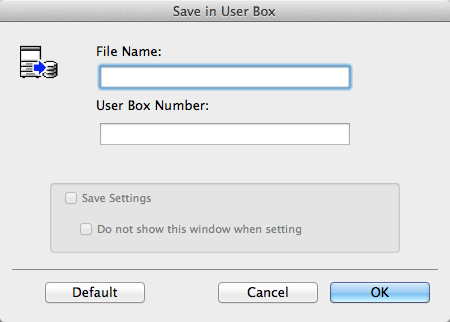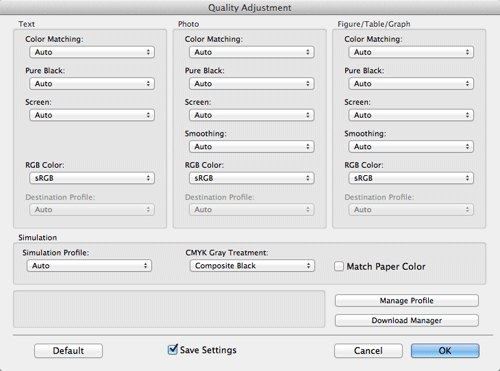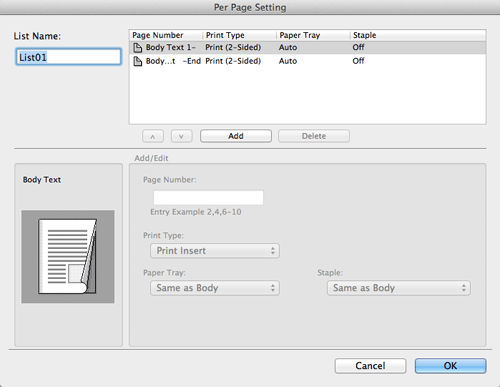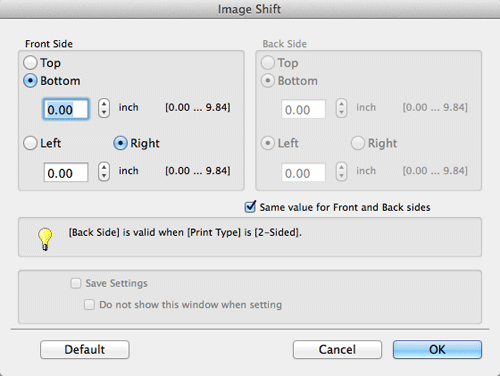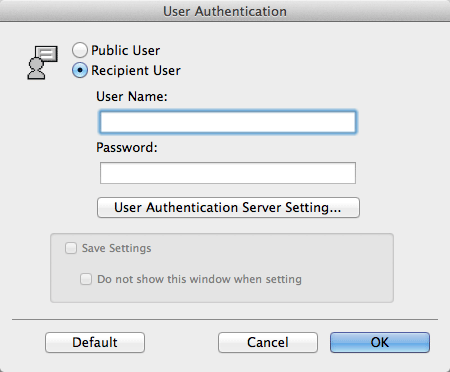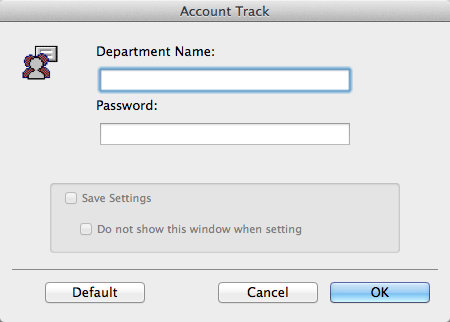
Printing in the Mac OS Environment
Saving the Number of Printed Sheets
To print on both sides of paper ([2-Sided])
Saving Paper by Printing on Both Sides ([2-Sided])
By using both sides of paper for printing, you can halve paper consumption.

In [Print Type:] in [Layout / Finish], select [2-Sided]. [2-Sided] is specified by default.
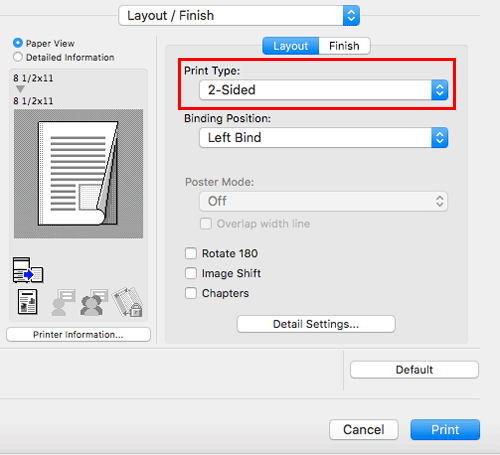
To save an original in a User Box of this machine ([Save in User Box])
Saving an Original in a User Box of This Machine ([Save in User Box])
About Save in User Box
The Save in User Box function saves print data in a User Box on this machine. You can also print the data at the same time as it is being saved in the box.
You can use multiple User Boxes for different purposes, for example:
By saving data in a User Box that all users can access (Public Box) or in a User Box that the members of a specific department can access (Group Box), you can distribute the data.
By saving data in the private box (Personal Box), you can assure security because only you can open the box. The data in the box is not deleted by mistake.

Registering a User Box on this machine
Register the boxes for storing print data on this machine.
For information on how to register a User Box, refer to Here.
Registering a User Box (Web Connection) (Here)
Setting Save in User Box on your computer
In [Output Method:] in the [Output Method] window, select [Save in User Box].
When you want to print the data at the same time it is saved in the box, select [Save in User Box and Print].
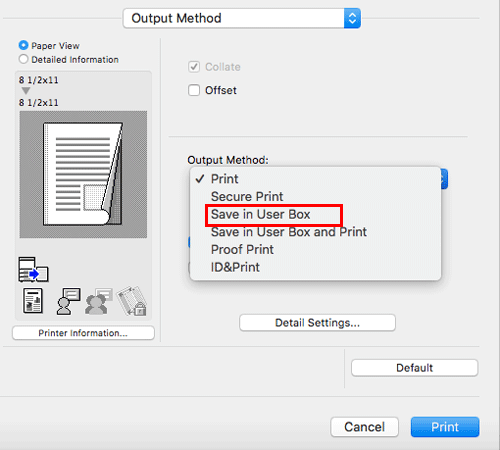
Enter the file name and the box number of the save location, click [OK].
Use a file name that helps you locate the data in the box.
When the [Save Settings] check box is selected, the settings are saved. When the [Do not show this window when setting] check box is selected, this dialog box is not displayed next time. If you always use the same file name and box number, selecting this check box eliminates the need to enter them each time.
Execute printing.
The data is saved in the box on this machine.
Using data in a User Box on this machine
You can print or send data saved in a User Box via E-mail or fax.
If data is saved in a User Box while [Resolution:] in [Quality] is set to [1200dpi (High Quality)], it cannot be sent. To send such data, set it to [600dpi].
Enlarging or Reducing an Original Image
To enlarge or reduce with the desired zoom ratio ([Scale:])
Enlarging or reducing by the desired zoom ratio ([Scale:])
You can print the original image after it has been enlarged or reduced by the desired zoom ratio.

In [Scale:] in [Page Attributes], specify the zoom ratio.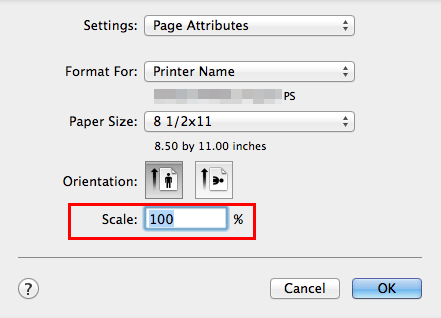
Printing Multiple Sets of Copies
To specify the number of copies ([Copies:])
Specifying the number of copies ([Copies:])
In [Copies:] in [Copies & Pages], specify the number of copies you want to print.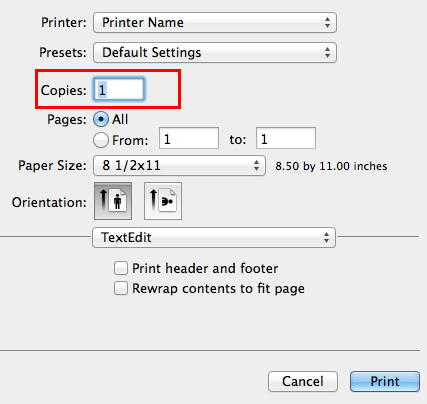
Making a trial printing (Proof Print) (Here)
To print by sets ([Collate]/[Offset])
Printing by sets ([Collate]/[Offset])
When multiple sets of copies are printed, the paper output position of each set is staggered to help you locate the first page of each set.
When the [Collate] check box in [Output Method] is selected, copies are output in a set-by-set manner, for example, "Pages 1, 2, 3, 4, and 5", "Pages 1, 2, 3, 4, and 5", and then "Pages 1, 2, 3, 4, and 5". When the [Offset] check box is selected, the output position is staggered one by one.
When you select both [Collate] and [Offset] check boxes, the output position is staggered for each set, allowing you to easily prepare handouts.
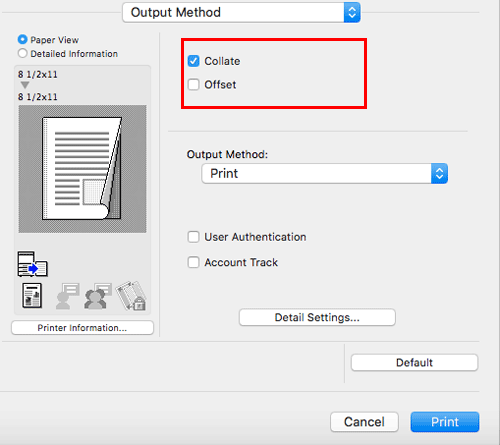
To make a trial printing in order to prevent misprints ([Proof Print])
Making a Trial Printing ([Proof Print])
About Proof Print
The Proof Print function is used when printing multiple copies. It allows the printer to output one copy and pause the printing operation before printing the remaining copies.
Because you can check the print result before starting printing the remaining copies, this function is helpful to prevent a lot of misprints.

Setting Proof Print on your computer
In [Output Method:] in the [Output Method] window, select [Proof Print].
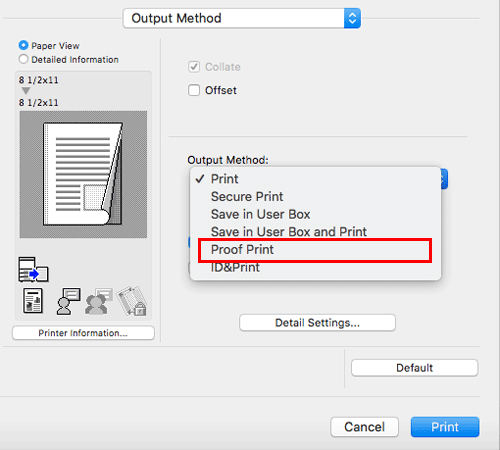
Specify the number of copies, then execute printing.
Only one copy is printed. Then, proceed to "Printing a Proof Print job on this machine". For details, refer to Here.
A job, which has been sent to this machine with [Proof Print] enabled, can be deleted remotely using Web Connection via the Web browser of the computer. For details on how to delete a job, refer to Here.
Selecting the Paper Size or Type for Printing
To print on custom size paper ([Page Setup])
Printing on custom size paper ([Page Setup])
For originals with a special size, print them on custom sized paper.
In [Paper Size:] under [Page Attributes], select [Manage Custom Sizes...], and specify the desired length and width.
In the [File] menu, click [Page Setup].
You can configure the same setting in [Format for:] in the [Print] window.
Open the window for registering a custom size.
Select [Manage Custom Sizes...] from the Paper Size list.
Click [+].
Enter the name of the paper size you are registering.
Be sure to use paper size names other than existing names, such as A4 and Custom.
Specify the length and width as desired.
If necessary, set the top, bottom, right, and left margins of the paper in [Non-Printable Area:].
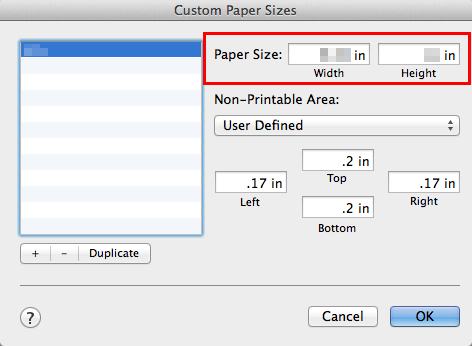
Click [OK].
This saves the custom paper size, which can be selected from the [Paper Size:] drop-down list in [Page Attributes].
For details on the trays into which you can load custom-size paper and the available range of sizes, refer to Here.
To change the paper type for printing ([Paper Type:])
Specifying the paper type ([Paper Type:])
In [Paper Type:] in [Paper Tray / Output Tray], select the type of paper for printing.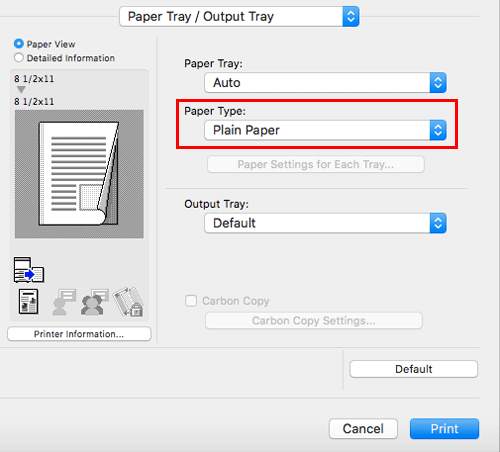
When [Paper Settings for Each Tray] is enabled in the [Installable Options] page of the printer driver, select [Paper Settings for Each Tray...] in [Paper Tray / Output Tray], and specify the paper type for each tray.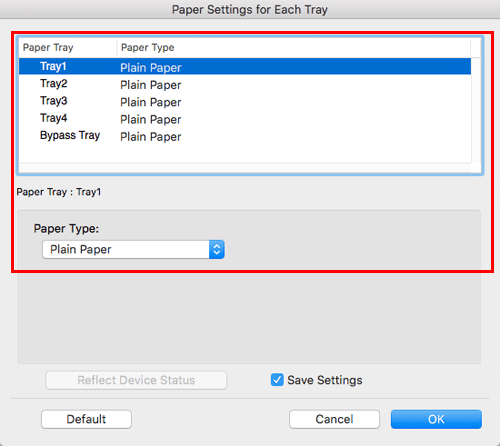
To specify the paper tray for printing ([Paper Tray:])
Specifying the paper tray ([Paper Tray:])
In [Paper Tray:] in [Paper Tray / Output Tray], select the paper tray for printing.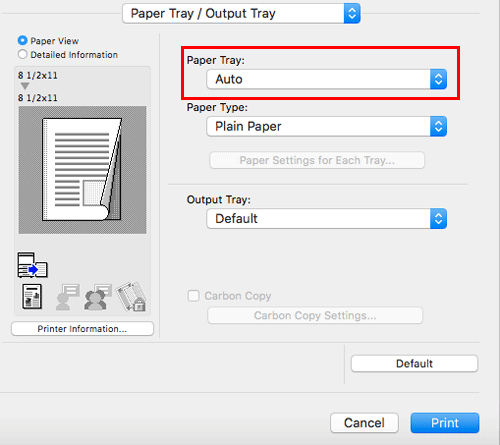
If you select [Auto], the paper tray for the paper you have selected in [Paper Size:] is automatically selected.
To print on paper in multiple trays ([Carbon Copy])
Printing on paper in multiple trays ([Carbon Copy])
You can print the original on different sheets of paper loaded into multiple trays. Because you can obtain printing results that look like carbon-copied slips using the print command once, this function is called Carbon Copy.
For example, by using the print command once, you can print a submission document on high-quality color paper loaded in Tray1 and print your copy on recycled paper loaded in Tray2.
This function is useful when you want to create a submission document and its copy at one time.

In [Paper Tray:] in [Paper Tray / Output Tray], select the paper tray for printing the original.
You cannot select [Auto].
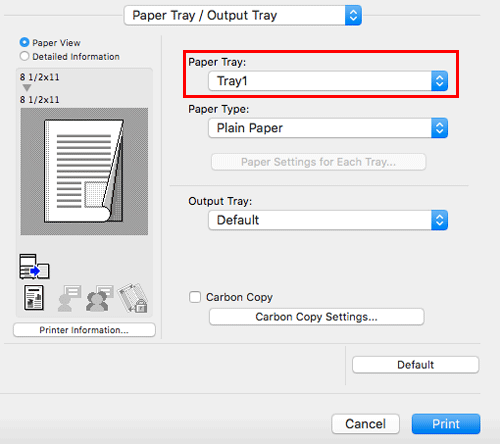
Select the [Carbon Copy] check box.
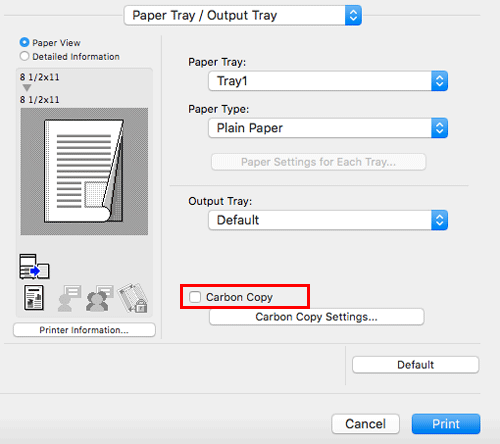
The [Carbon Copy Settings] window appears.
Specify the paper tray for carbon copies and output order, and click [OK].
Setting
Description
[Original Copy]
The paper tray for printing the original is displayed.
[Carbon Copy Tray]
Select the paper tray for carbon copies. Select the check boxes for all paper trays to be used.
[Output Order]
Select the order of outputting carbon copies.
[Tray]: Carbon copies are printed in order of selected trays. When an original comprised of multiple pages is printed, all pages are printed on paper from one tray, then the next tray is used.
[Page]: Carbon copies are printed page by page. When an original comprised of multiple pages is printed, each page is printed on paper from all the selected trays.
[Save Settings]
When the Save Setting check box is selected, the settings are saved.
When the [Do not show this window when setting] check box is selected, this dialog box is not displayed when [Carbon Copy] is enabled. Using this function, you can save steps to configure settings the next time and after if you always specify the same carbon copy tray settings to execute a print job.
To print on banner paper
Printing on Banner Paper
About printing on banner paper
This machine accommodates paper with a length of up to 47-1/4 inches (1200 mm) in the Bypass Tray.

Printable paper
Paper width | Paper length | Paper weight |
|---|---|---|
3-9/16 to 11-11/16 inches (90 mm to 297 mm) | 18 to 47-1/4 inches (457.3 mm to 1200 mm) | 33-13/16 to 55-7/8 lb (127 g/m2 to 210 g/m2) Using the printer driver, select the paper type appropriate for the weight of the banner paper to be used.
|
How to print on banner paper
Register the size of the banner paper, then specify the registered size.
On the screen of this machine, tap [Utility] - [Banner Printing].
Select [Allow], and tap [OK].
Check that the system is changed to the banner print job wait state.
When you have finished the above settings, start to print from the PC.
In the [Page Setup] window, open the window for registering a custom size.
Select [Manage Custom Sizes...] from the Paper Size list.
Click [+].
Enter the name of the paper size you are registering.
Be sure to use paper size names other than existing names, such as A4 and Custom.
Configure the following items.
[Page Size:]: Specify the length and width as desired.
Specify the paper size within the allowable range of the banner size (Width: 3-9/16 to 11-11/16 inches (90 mm to 297 mm), Length: 18 to 47-1/4 inches (457.3 mm to 1200 mm)).
[Non-Printable Area:]: Specify the top, bottom, right, and left margins of the paper.
Click [OK].
The custom paper size is then registered.
In [Paper Size:] in [Page Attributes], select the registered paper size.
The registered paper size can also be selected in [Paper Size:] on the print screen.
To display the Print window, click [Print] in the [File] menu.
Check to see that the custom paper size (registered in Step 8) is shown in the [Destination Paper Size] of [Paper Handling].
Check that [Paper Tray:] of [Paper Tray / Output Tray] is set to [Bypass Tray] and that the [Paper Type:] is set to the desired paper type ([Thick 1+]/[Thick 2]/[Thick 3]).
If the specified paper size is not in the allowable range of the banner size, [Paper Tray:] or [Paper Type:] is not grayed out to enable you to change them. In this case, check the setting of the custom paper size.
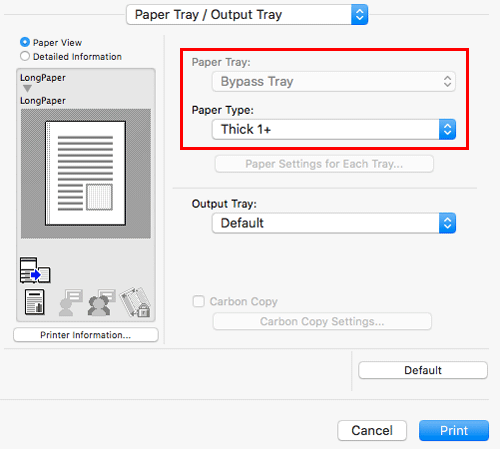
Execute printing.
A message that prompts you to load paper is displayed on the screen of this machine.
Load the banner paper into the Bypass Tray.
For information on how to load banner paper into the Bypass Tray, refer to Here.
When you have loaded a banner paper, tap [Complete].
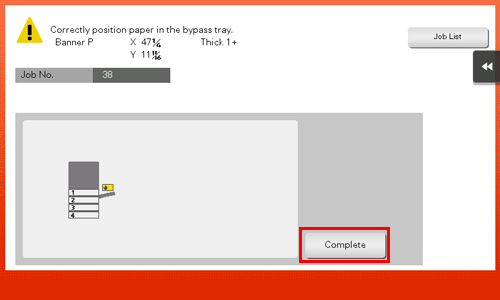
Printing on the banner paper starts. Support the ejected banner paper by hand. To continue printing, execute printing from the computer.
Tap [Exit].
A message confirming the end of banner printing is displayed. To terminate printing, tap [Yes].
If there is a queued job, the job is started.
Adjusting the Color Quality to Obtain a Nice-Looking Print Image
To select colors for printing ([Select Color:])
Selecting colors for printing ([Select Color:])
Select colors for printing. There are three color modes: [Auto Color] that fits the original color, [Full Color] and [Gray Scale].

In [Select Color:] in [Quality], select a color mode for printing.
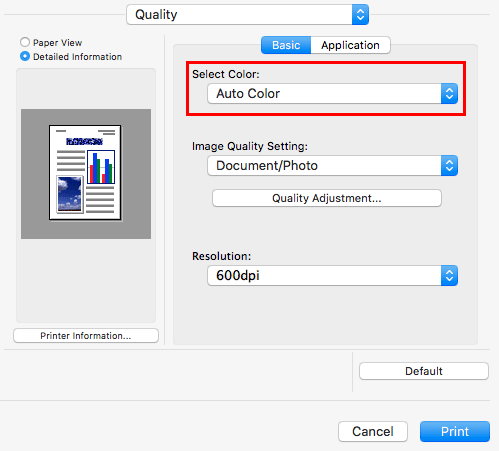
To automatically adjust to the available image quality settings for the original ([Image Quality Setting:])
Selecting the optimum color representation for the original ([Image Quality Setting:])
Select the optimum settings for the original to print it at the optimum image quality level.
Select one of the following processes according to the original to be printed; the process suitable for originals consisting primarily of text, the process suitable for photos, the process suitable for originals created with DTP, or the process suitable for printing CAD data.

In [Image Quality Setting:] of [Quality], select the image setting mode to suit the original.
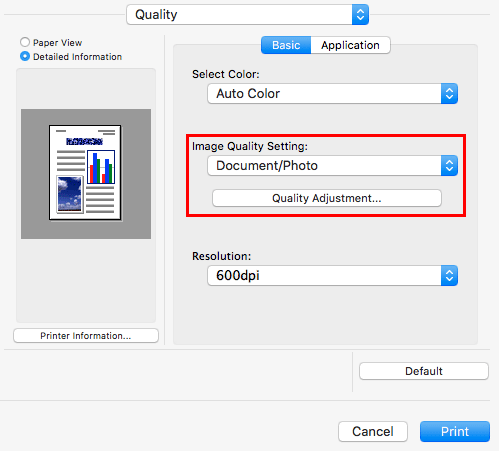
To print images with a glossy finish ([Glossy Mode])
Making the image glossy ([Glossy Mode])
Images are printed with a glossy finish.
In [Quality], select the [Glossy Mode] check box.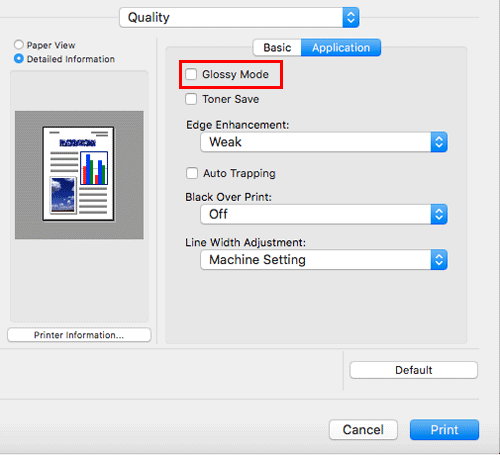
This function is enabled when [Print Type:] is set to [1-Sided].
To prevent the generation of white space around images ([Auto Trapping]/[Black Over Print:])
Preventing the generation of white space around images ([Auto Trapping]/[Black Over Print:])
The generation of white space on the boundary between different colors or around characters is prevented.
In [Quality], select the [Auto Trapping] check box or configure the [Black Over Print:] setting.
Select the [Auto Trapping] check box to superimpose neighboring colors to print so as to prevent generation of white space around a picture.
Configure the [Black Over Print:] setting to superimpose black color on a neighboring color to print so as to prevent generation of white space around black characters or figures. You can select whether to print black only around the characters or around both characters and figures.
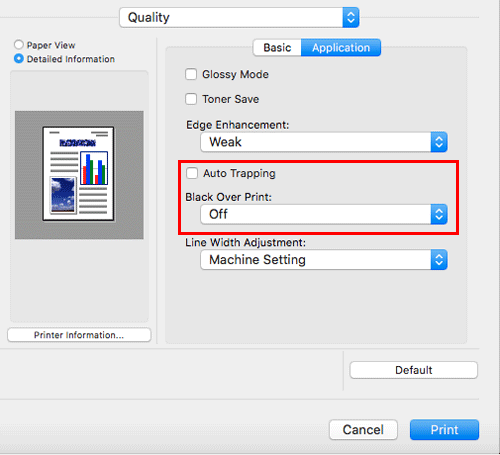
To adjust the printing density in order to reduce toner consumption ([Toner Save])
Saving toner ([Toner Save])
Selecting the [Toner Save] check box in [Quality] adjusts the printing density in order to save the amount of toner consumed.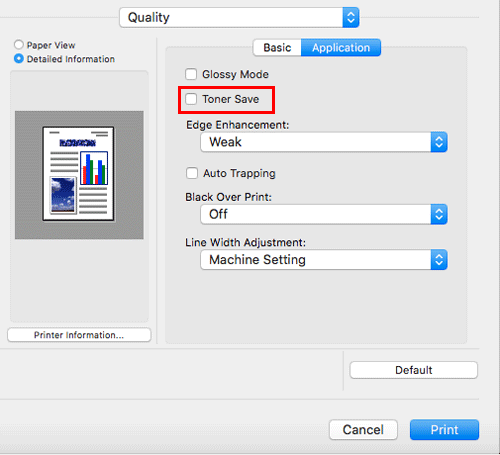
To sharpen the border between text, etc. ([Edge Enhancement])
Increasing the legibility of small or faint text ([Edge Enhancement])
Sharpen the edges of images such as text in the table and graphics to improve legibility.
In [Edge Enhancement] of [Quality], select the level to highlight.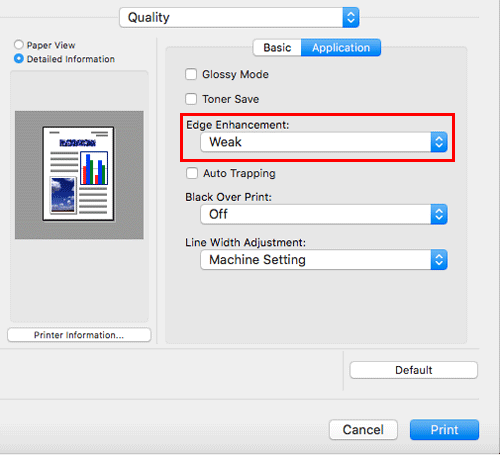
To use ICC profiles
Using ICC Profiles
Specifying the ICC profiles for printing
Specify and print the ICC profiles registered in this machine with the printer driver.
In [Quality], click [Quality Adjustment...].
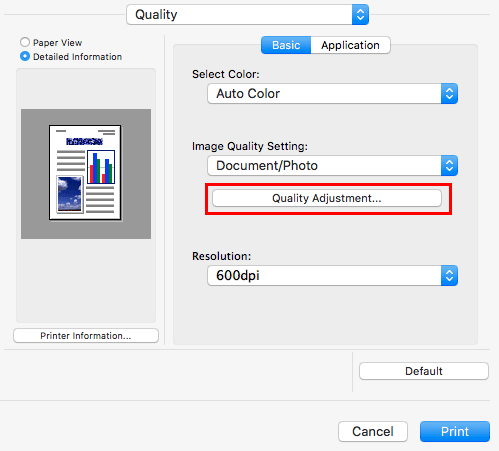
Specify the settings for [RGB Color:], [Destination Profile:], and [Simulation Profile:].
The ICC profiles registered in the printer driver can be selected.
Click [OK].
Color processing is performed according to the selected ICC profiles.
Finishing in Handouts or Booklet Format
To staple paper ([Staple:])
Stapling paper ([Staple:])
Each set of sheets can be stapled (at a corner or at two positions) and output automatically. This function is useful for preparing a project proposal or other booklet materials.

In [Layout / Finish], select the [Staple:] check box. In addition, specify the number and positions of staples.
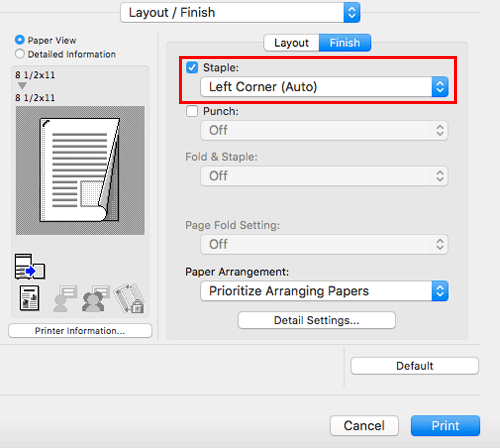
To use this function, an option is required. For details on the required option, refer to Here.
In [Binding Position:] in [Layout / Finish], specify the staple position.
To punch the printed sheets ([Punch:])
Punching the printed sheets ([Punch:])
Printed sheets are punched for filing before they are output. This function is useful when you want to bind printed materials in files.
In [Layout / Finish], select the [Punch:] check box. In addition, specify the number and positions of punch holes.
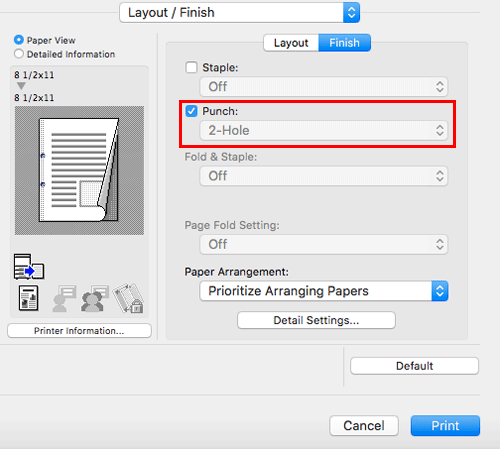
To use this function, an option is required. For details on the required option, refer to Here.
In [Binding Position:] in [Layout / Finish], specify the punch position.
The number of punched holes varies depending on the area you are in.
To fold paper ([Fold & Staple:])
Folding papers ([Fold & Staple:])
The printed sheets are creased before they are output.
Half-Fold

Tri-Fold

Z-Fold

In [Fold & Staple:] in [Layout / Finish], select the folding mode.
When you want to fold page by page, specify the number of pages to be folded at one time in [Page Fold Setting].
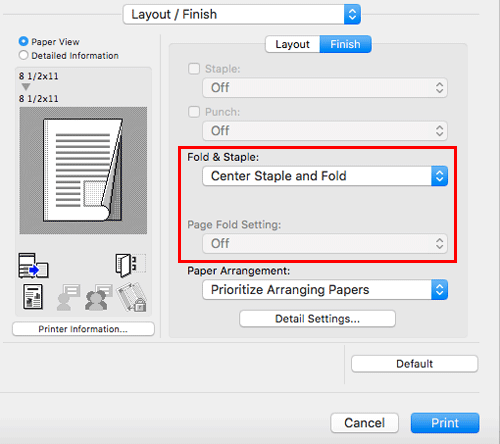
To use this function, an option is required. For details on the required option, refer to Here.
When using the Z-fold function, specify the paper size indicated in the setting value ([Z-Fold (A3, B4, 11 17, 8K)] or [Z-Fold (8 1/2 14)]), which you select from the drop-down list, in "Paper Size" of the application software or printer driver.
This function cannot be used on originals that contain more pages than the number of pages that can be folded by this machine.
To print in booklet format ([Booklet])
Printing in a booklet format ([Booklet])
The pages in the original data are arranged and spread out in booklet format and printed on both sides of sheets. When the printed sheets are stacked and folded in two, the pages are arranged in the correct order.
In [Print Type:] in [Layout / Finish], select [Booklet].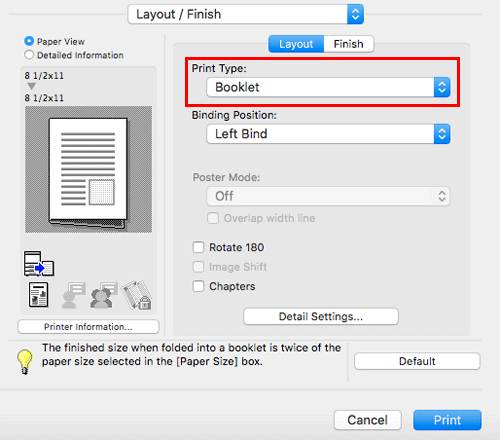
In [Paper Size], select the finishing size when paper is folded as a booklet.
By selecting [Chapters] in [Layout / Finish] in combination with this function, you can place the specified page on the front side.
To bind in the center of the paper ([Fold & Staple:])
Binding in the center of the paper ([Fold & Staple:])
The printed sheets are bound in the center and folded before they are output.

In [Fold & Staple:] in [Layout / Finish], select [Center Staple and Fold].
As the sheets are bound in the center, use the combined document data or set the [Print Type:] to [Booklet] on the [Layout / Finish] tab.
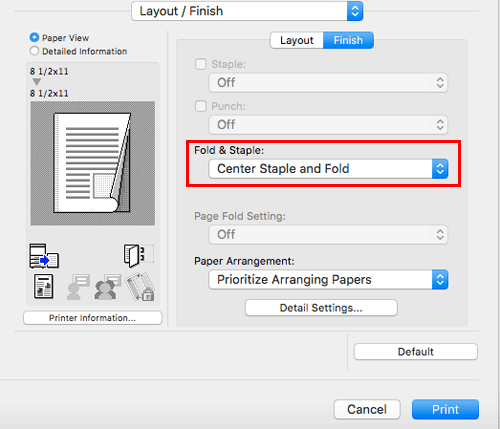
To use this function, an option is required. For details on the required option, refer to Here.
To specify the output tray ([Output Tray:])
Specifying the output tray ([Output Tray:])
In [Output Tray:] in [Paper Tray / Output Tray], select the tray to which printed sheets are output.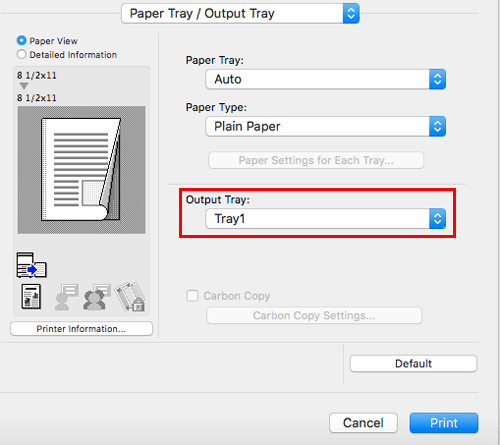
Adding the Date/Time, Page Number, or Stamp to Printouts
To add the print date/time ([Date/Time])
Adding the date and time ([Date/Time])
You can add the print date/time to your printouts. If necessary, you can select the print position and format of the text.

In [Stamp / Composition], select the [Date/Time] check box.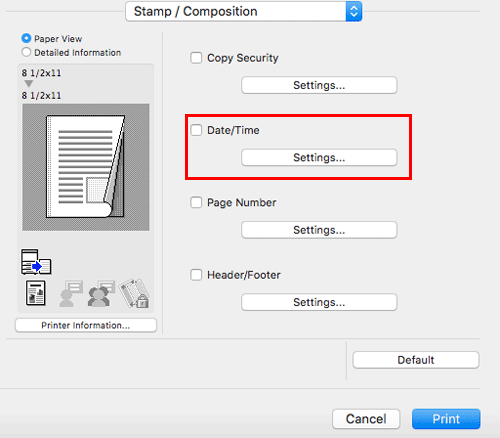
As necessary, click [Settings...] to change the print position and format of the text.
Setting | Description |
|---|---|
[Format:] | Specify the format for the date/time. |
[Pages:] | Specify the range of pages on which the date/time is printed. |
[Text Color:] | Select the print color for the date/time. |
[Print Position:] | Specify the print position for the date/time. |
To add a page number ([Page Number])
Adding a page number ([Page Number])
You can add page numbers to your printouts. If necessary, you can select the print position and the page from which the page number printing starts.
In [Stamp / Composition], select the [Page Number] check box.
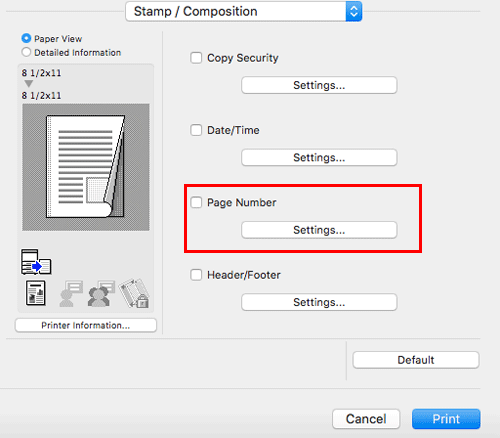
As necessary, click [Settings...] to change the print position and the page from which the page number printing starts.
Setting | Description |
|---|---|
[Starting Page:] | Specify the page from which the page number printing starts. |
[Starting Page Number:] | Specify the page number to be printed on the page specified in [Starting Page:]. |
[Cover Mode:] | Select this check box to print page numbers on the front and back covers when they are inserted. In addition, select the format. |
[Text Color:] | Select the print color for the page numbers. |
[Print Position:] | Specify the print position for the page numbers. |
To add information to the header/footer ([Header/Footer])
Adding information to the header/footer ([Header/Footer])
You can add and print the date and time and arbitrary text in the top or bottom margin (header/footer) of the original. You must register the information to be added for the header and footer in advance on this machine. For details on the registration procedure, refer to Here.

In [Stamp / Composition], select the [Header/Footer] check box, then click [Settings...].
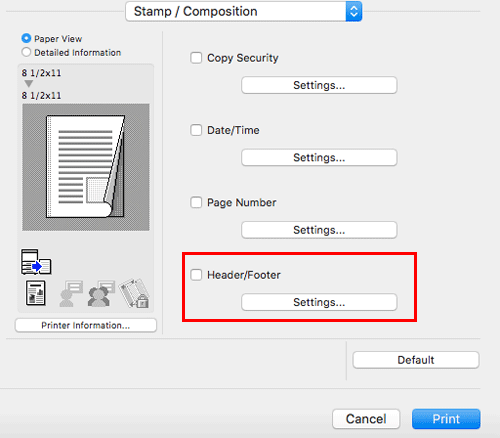
Select the information to be added to the header/footer, and click [OK].
As necessary, change the range of pages on which the header/footer is printed and other settings.
Setting
Description
[Recall Header/Footer:]
Select the header/footer to be recalled.
[Distribution Control Number:]
Select whether to print copy numbers when printing multiple sets of copies.
[Print in Header]: Select this check box to print the copy number in the header.
[Print in Footer]: Select this check box to print the copy number in the footer.
[Start Number]: Specify the format for the copy numbers and the page from which the copy number printing starts.
[Pages:]
Select the range of pages on which the text is printed in the header/footer.
[Text Color:]
Select the color of the text to be added to the header/footer.
Inserting a Front Cover or Different Original Page into the Original
To insert front and back covers ([Front Cover:]/[Back Cover:])
Inserting front and back covers ([Front Cover:]/[Back Cover:])
You can insert a cover sheet before the first page or after the last page of the text.
The front and rear cover sheets can be a paper different from body pages (in paper color and thickness). You can print them at a time.

In [Paper Tray:] in [Paper Tray / Output Tray], select the paper tray for printing the body.
You cannot select [Auto].
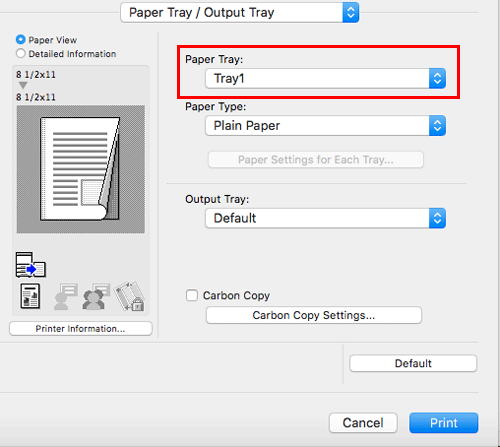
In [Cover Mode], select the [Front Cover:] and [Back Cover:] check boxes.
If necessary, you can select whether to print the original on the inserted sheets or to leave them blank. When the inserted sheets are printed, the first page of the original is printed on the front cover and the last page of the original is printed on the back cover.
Select the paper trays for paper to be inserted as the front and back covers.
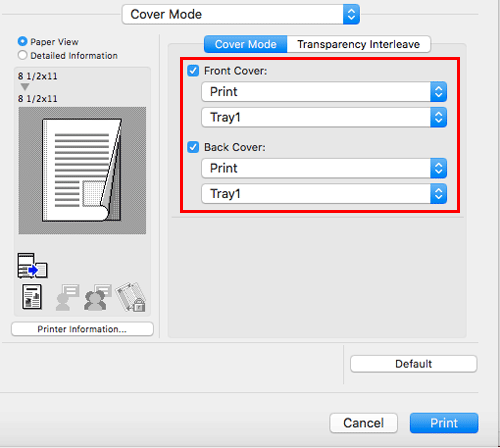
To insert front and back covers using the Post Inserter ([Front Cover from Post Inserter:]/[Back Cover from Post Inserter:])
Inserting front and back covers ([Front Cover from Post Inserter:]/[Back Cover from Post Inserter:])
You can insert the optional Post Inserter paper before the first page or after the last page of the original as the outer front cover.

In [Paper Tray:] in [Paper Tray / Output Tray], select the paper tray for printing the body.
You cannot select [Auto].

In [Cover Mode], select the [Front Cover from Post Inserter:] and [Back Cover from Post Inserter:] check boxes.
Select the PI tray for the paper to insert as the front and back covers.
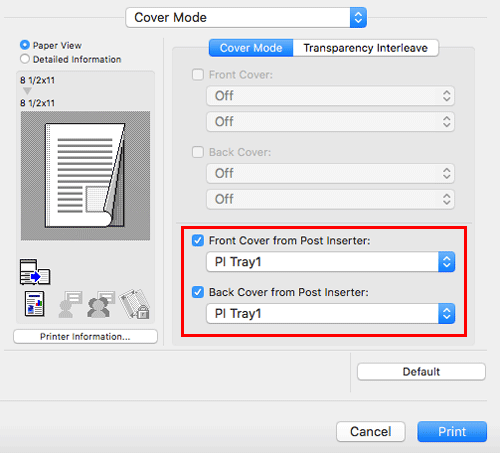
To print by inserting paper between transparencies ([Transparency Interleave:])
Inserting paper between transparencies ([Transparency Interleave:])
When printing on multiple transparencies, you can insert the specified paper between the transparencies. These sheets of paper prevent the transparencies from sticking together due to heat generated during printing or static electricity.

In [Print Type:] in [Layout / Finish], select [1-Sided].
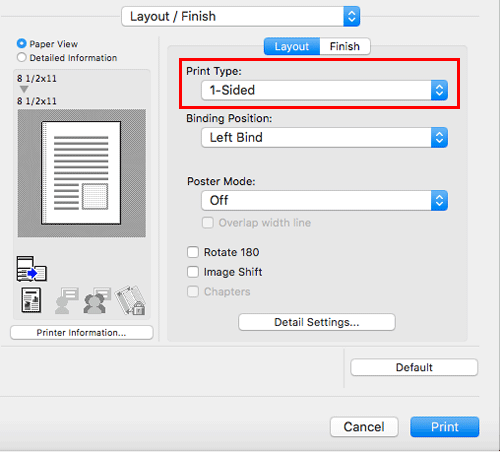
In [Select Color:] in [Quality], select [Gray Scale].
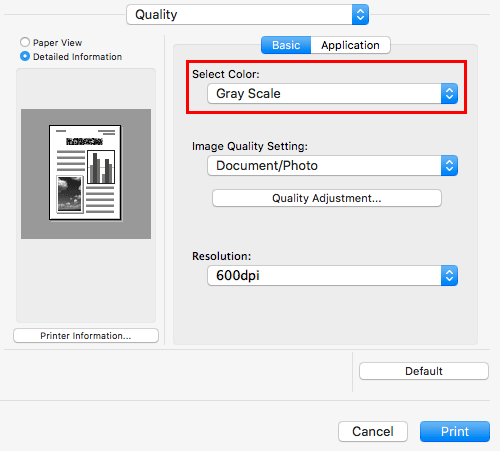
In [Paper Type:] in [Paper Tray / Output Tray], select [Transparency].
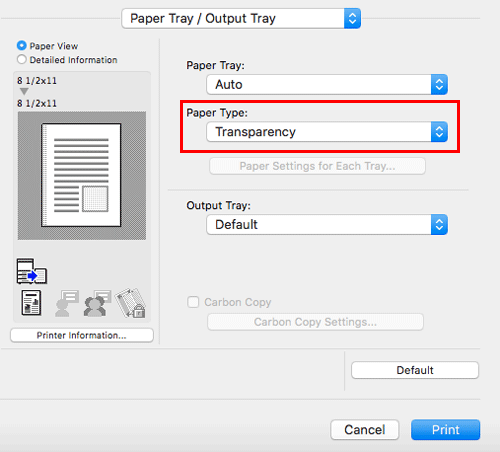
In [Cover Mode], select [Transparency Interleave:] check box.
Select the paper tray for the paper to be inserted between transparencies.
Transparency Interleaves are inserted as blank sheets.
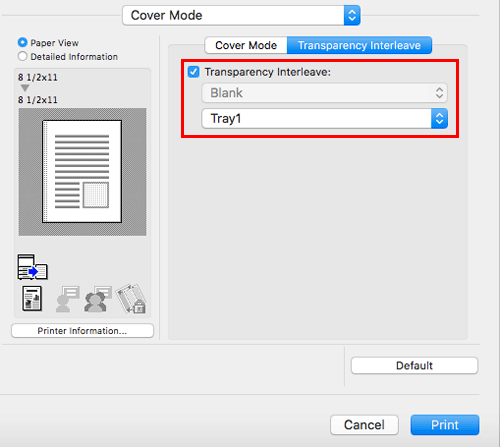
To insert paper into the specified pages ([Per Page Setting:])
Inserting paper into the specified pages ([Per Page Setting:])
Paper different from other pages is inserted into the specified pages.
You can insert a color paper and a thick paper. You can also select whether to print the original on the inserted paper.

Create in advance a list that specifies the paper and print settings for each page. When printing on inserted paper, select the list you want to apply to printing.
In [Per Page Setting], select the [Per Page Setting:] check box, and the click [Add...].
If nothing is registered in the list, selecting the [Per Page Setting:] check box automatically displays the setting window.
When you have already prepared a list, select the list you want to apply to printing.
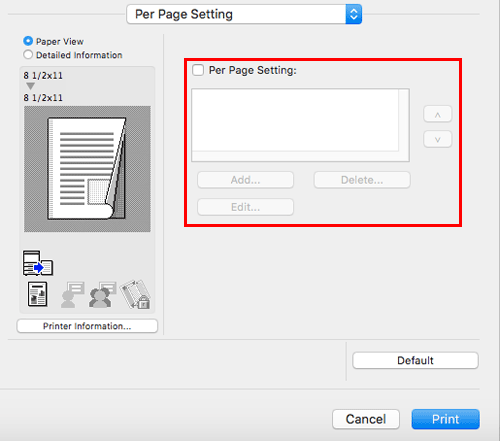
Create a list by specifying the paper and print settings for each page.
Setting
Description
Settings List
The settings for each page are displayed in a list.
[List Name:]
Enter the name of the list to be created.
[]/[]
These buttons move the order of settings in the list. They do not change the settings.
[Add]
This button adds the setting to the list.
[Delete]
This button deletes the setting selected in the list.
[Add/Edit]
You can add settings to the Settings List or edit settings.
[Page Number:]
Enter the page numbers you want to add.
To specify multiple page numbers, separate each number with a comma (for example, "2,4,6") or connect the numbers using a hyphen (for example, "6-10").
[Print Type:]
Select the print type applied when printing the specified pages.
[Paper Tray:]
Select the paper tray for printing the specified pages.
[Staple:]
Select the staple position applied when the specified pages are stapled.
Click [OK].
Adjusting the Layout for Printing
To print a poster-sized image ([Poster Mode:])
Printing a poster-sized image ([Poster Mode:])
The original image is enlarged, divided, and printed on multiple sheets. When you join the printed sheets together, a large poster is created.
In [Poster Mode:] in [Layout / Finish], select "N N". For example, when you select [2 2], one page of the original image is enlarged, divided, and printed on four sheets.
To create overlap margins, select the [Overlap width line] check box.
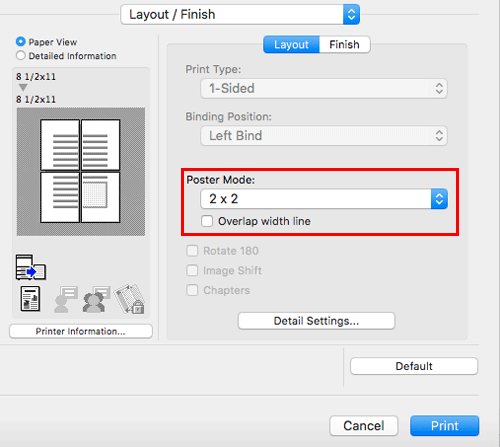
To rotate the image 180 degrees ([Rotate 180])
Rotating the image 180 degrees ([Rotate 180])
The image is printed upside down. Use this function when printing on envelopes whose loading direction cannot be changed.
In [Layout / Finish], select the [Rotate 180] check box.
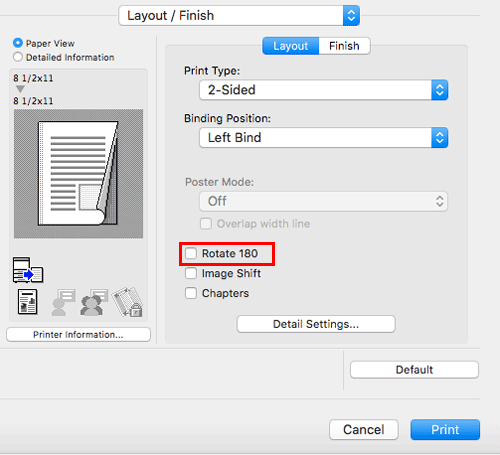
To fine-adjust the print position ([Image Shift])
Fine-tuning the print position ([Image Shift])
You can fine tune the image position by shifting it in a horizontal or vertical direction according to the paper size. When an image is printed on the back side, you can also fine tune its position.
Use this function when you want to make a fine adjustment, such as changing the print position a little or printing images in different positions between the front and back sides.
In [Layout / Finish], select the [Image Shift] check box.
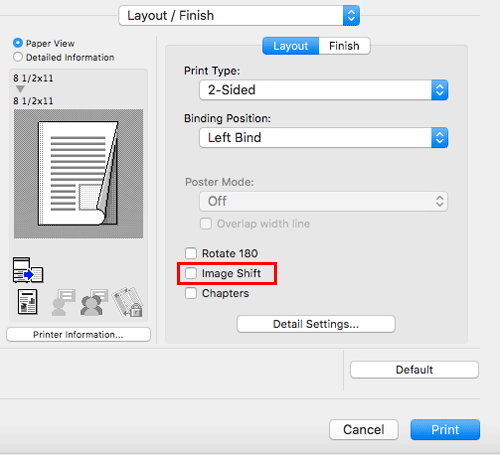
The [Image Shift] window appears.
Adjust the upward/downward and rightward/leftward shift distances, and click [OK].
When printing images on both sides, selecting the [Same value for Front and Back sides] check box applies the same settings to both sides.
Restricting a Handout Copy or Printing a Highly Confidential Document
To print a concealed security watermark that appears when copied ([Copy Protect])
Adding a concealed security watermark ([Copy Protect])
Text such as "Copy" and "Private" are printed in the background pattern as concealed text. This function is called the Copy Protect function.
When a copy-protected document is copied, the concealed security watermark appears on the entire page, thereby indicating that it is an unauthorized copy.

In [Stamp / Composition], select the [Copy Security] check box, then click [Settings...].
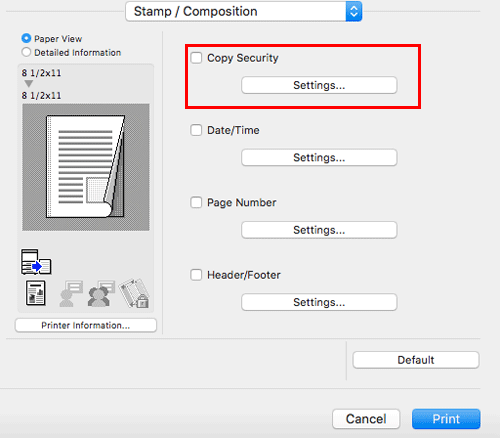
Select [Copy Protect], and click [OK].
As necessary, specify the text to be printed and the format of the text. For details, refer to Here.
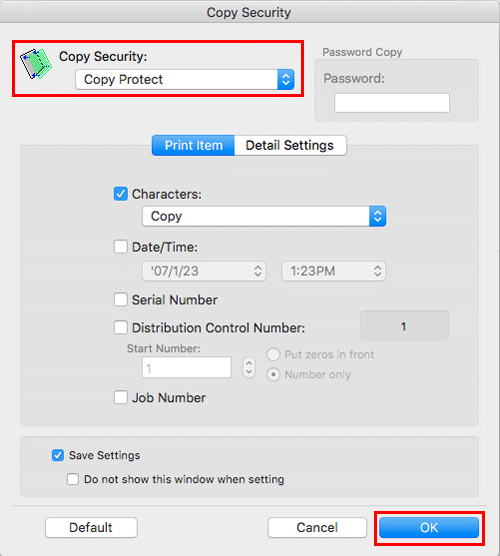
To print stamps such as "Copy" and "Private" on the entire page ([Stamp Repeat])
Printing a stamp on the entire page ([Stamp Repeat])
Print a stamp such as "Copy" or "Private" on the entire page.
By printing text such as "Copy" or "Private" as a visible stamp, you can deter unauthorized copying.

In [Stamp / Composition], select the [Copy Security] check box, then click [Settings...].

Select [Stamp Repeat], and click [OK].
As necessary, specify the text to be printed and the format of the text. For details, refer to Here.
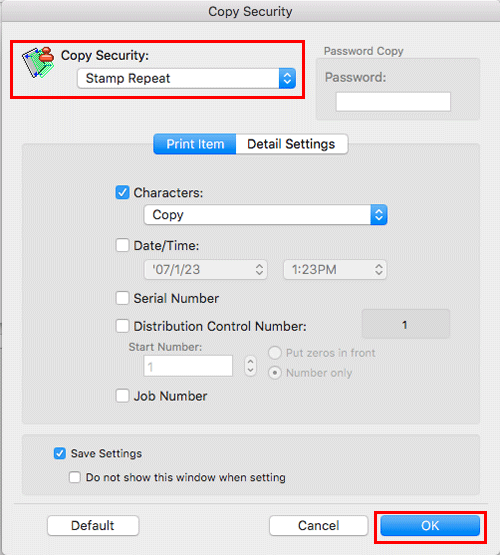
To embed copy restriction information in the copy protection function that prints concealed security watermarks in the background ([Copy Guard])
Adding copy restriction information ([Copy Guard])
Copy Guard is a copy protection function that prints concealed security watermarks such as "Private" or a date in the background to prevent unauthorized copying, and embeds a copy restriction pattern on all printed sheets.
If an attempt is made using a device that supports the copy guard function to copy a sheet that has been copy protected, a copy guard pattern is scanned, the copying process is canceled, and the job is deleted.

In [Stamp / Composition], select the [Copy Security] check box, then click [Settings...].

Select [Copy Guard], and click [OK].
As necessary, specify the text to be printed and the format of the text. For details, refer to Here.
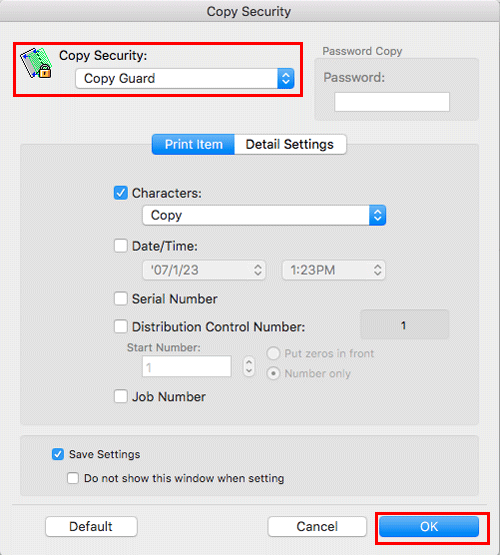
To embed a password in the copy protection function that prints concealed security watermarks in the background ([Password Copy])
Adding a password ([Password Copy])
Password Copy is a copy protection function that prints concealed security watermarks such as "Private" or a date in the background to prevent unauthorized copying, and embeds a password for the password copy function on all printed sheets.
If an attempt is made using a device that supports the password copy function to copy a sheet that has been prepared for password copy, a password copy pattern is scanned and entry of a password is requested. Copying starts if the correct password is entered.

In [Stamp / Composition], select the [Copy Security] check box, then click [Settings...].

Select [Password Copy], enter the password to be embedded (using up to eight characters), and then click [OK].
As necessary, specify the text to be printed and the format of the text. For details, refer to Here.
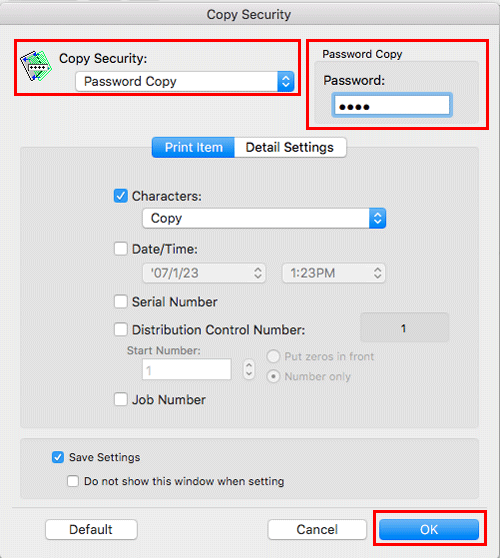
To print a highly confidential document ([Secure Print])
Printing Highly Confidential Documents ([Secure Print])
About Secure Print
Secure Print is a function that assigns document ID and password to print data and saves the data to the Secure Print User Box of this machine. This function does not print data immediately, thereby preventing printed materials from being missing or left.
You need to enter the document ID and password on the screen of this machine to print the data saved in a User Box. Therefore, this function is particularly suitable for safely printing highly confidential documents.

Enabling simple printing for secure print document (for the administrator)
If simple printing for secure print document is enabled, the computer login name is used as the document ID for Secure Print, so you can skip the entry of the document ID.
Also, if the computer login name is used as the document ID for Secure Print, it prevents the document ID from being duplicated with that of another user, which simplifies document management on this machine.
When making prints on the machine, the user can display a list of document IDs on the screen of this machine and easily specify the target document ID.
To enable simple printing of secure documents, configure the following settings.
Enable simple printing of secure documents on this machine (default: [Do Not Release Secure Print]). For details on the setting procedure, refer to Here.
In the [Installable Options] page on the printer driver, set [Security Document Setting] to [Release Secure Print] (default: [Do Not Release Secure Print]). For details on [Installable Options], refer to Here.
When simple printing is disabled, the document ID can be specified using up to 16 characters. If simple printing is enabled, the document ID can be extended to up to 64 characters.
If simple printing is changed from Enable to Disable while the document ID is specified using 17 or more characters, it will cause document operations to fail.
Setting Secure Print on your computer
A single job enables you to print out a document of up to 2999 pages in length.
In [Output Method:] in the [Output Method] window, select [Secure Print].
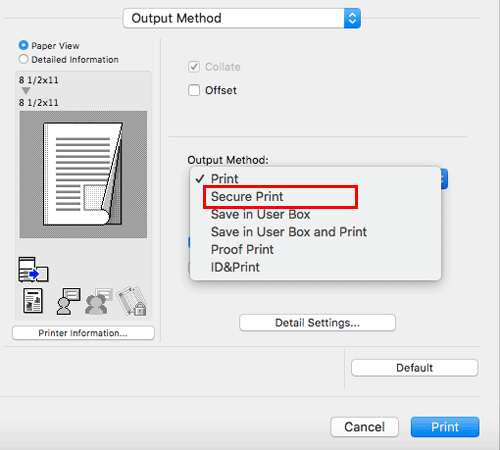
Enter the document ID and password, then click [OK].
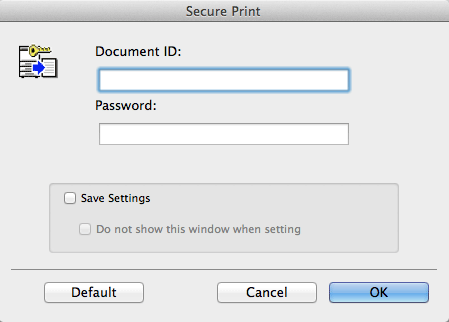
When the [Save Settings] check box is selected, the settings are saved. When the [Do not show this window when setting] check box is selected, this dialog box is not displayed next time. If you always use the same document ID and password, selecting this check box eliminates the need to enter them each time.
Execute printing.
The data is saved in the Secure Print User Box. Then, proceed to "Printing a Secure Print job on this machine". For details, refer to Here.
You can issue a print instruction from the screen of this machine before print data scanning on this machine is completed. However, printing is executed after print data scanning on this machine has been completed.
Printing in the Environment with User Authentication Installed
To add authentication information for printing
Attaching Authentication Information
About printing with authentication enabled
When printing a document in an environment where user authentication or account track is employed, you need to send the authentication information (user name and password) to this machine to execute printing. This requirement limits the users who can use this machine, preventing unauthorized use by a third party.
When this machine receives a print job from a user who is not allowed to print or a print job without authentication information, this machine automatically discards the job.

A print job without authentication information refers to a print job that is directly sent to this machine from an enterprise system such as ERP (Enterprise Resource Planning) or a print job that is sent without correctly configuring the User Authentication/Account Track setting using the printer driver.
By default, the printing of a job without authentication information is prohibited. To permit printing, the appropriate setting is required in [Print without Authentication] (Here). If printing is permitted, the unregistered user or account can execute printing even despite the intention of the administrator. If there is any problem on security or management, you should not change the initial settings.
Setting authentication information on your computer
In the [Output Method] window, select the [User Authentication] check box (and the [Account Track] check box).
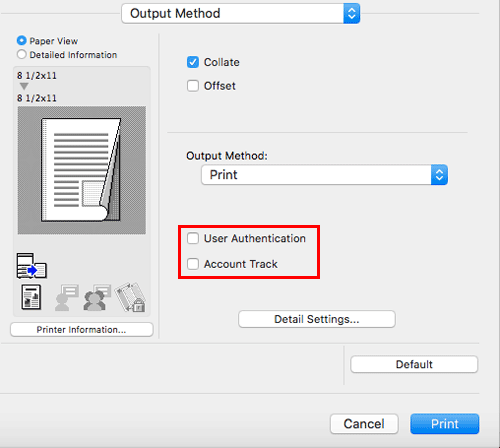
When user authentication is enabled, select [Recipient User], enter the user name and password, then click [OK].
When this machine is accessible to public users (unregistered users), selecting [Public User] enables you to execute printing without entering the user name and password.
When an external authentication server is used, click [User Authentication Server Setting...], then select the authentication method and authentication server. To perform MFP authentication when external server authentication is used together, specify the MFP as an authentication server.
When the [Save Settings] check box is selected, the settings are saved. When the [Do not show this window when setting] check box is selected, this dialog box is not displayed next time. If you always use the same user name and password, selecting this check box eliminates the need to enter them each time.
If account track is enabled, enter the account name and password, then click [OK].
When the [Save Settings] check box is selected, the settings are saved. When the [Do not show this window when setting] check box is selected, this dialog box is not displayed next time. If you always use the same account name and password, selecting this check box eliminates the need to enter them each time.
Execute printing.
Printing starts successfully when the authentication information is judged to be correct.
To print a highly confidential document ([ID & Print])
Printing Simultaneously with Authentication on this Machine ([ID & Print])
About ID & Print
ID & Print is a function that saves print data to the ID & Print User Box of this machine when user authentication is installed. This function does not print data immediately, thereby preventing printed materials from being missing or left.
You need to perform user authentication on this machine to print the data saved in the User Box. Therefore, this function is suitable for safely printing highly confidential documents. When authentication succeeds, the print data of the login user is automatically printed. This enhances security as well as ensures smooth operation.

Setting ID & Print on your computer
A single job enables you to print out a document of up to 2999 pages in length.
In the [Output Method] window, select the [User Authentication] check box.
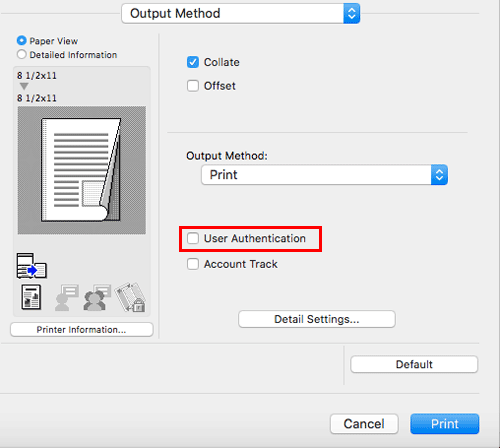
Select [Recipient User], enter the user name and password, then click [OK].
In [Output Method:], select [ID&Print].
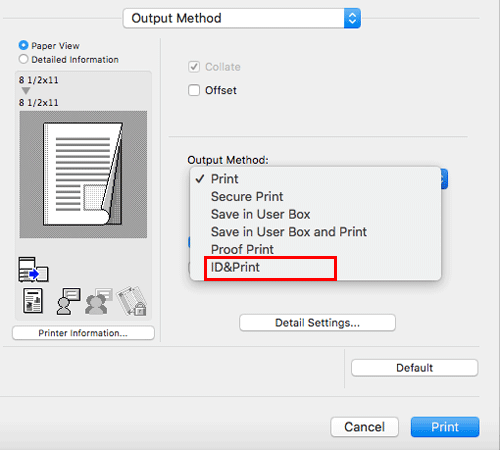
Execute printing.
The data is saved in the ID & Print User Box. Then, proceed to "Printing an ID & Print job on this machine".
When printing all jobs: Here
When printing a specific job: Here
When using Authentication Unit: HereYou can issue a print instruction from the screen of this machine before print data scanning on this machine is completed. However, printing is executed after print data scanning on this machine has been completed.

